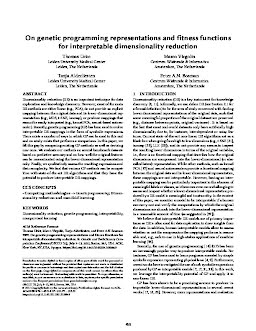2022-07-08
On genetic programming representations and fitness functions for interpretable dimensionality reduction
Publication
Publication
Dimensionality reduction (DR) is an important technique for data exploration and knowledge discovery. However, most of the main DR methods are either linear (e.g., PCA), do not provide an explicit mapping between the original data and its lower-dimensional representation (e.g., MDS, t-SNE, isomap), or produce mappings that cannot be easily interpreted (e.g., kernel PCA, neural-based autoencoder). Recently genetic programming (GP) has been used to evolve interpretable DR mappings in the form of symbolic expressions. There exists a number of ways in which GP can be used to this end and no study exists that performs a comparison. In this paper, we fill this gap by comparing existing GP methods as well as devising new ones. We evaluate our methods on several benchmark datasets based on predictive accuracy and on how well the original features can be reconstructed using the lower-dimensional representation only. Finally we qualitatively assess the resulting expressions and their complexity. We find that various GP methods can be competitive with state-of-the-art DR algorithms and that they have the potential to produce interpretable DR mappings.
| Additional Metadata | |
|---|---|
| , , , | |
| doi.org/10.1145/3512290.3528849 | |
| 2022 Genetic and Evolutionary Computation Conference, GECCO 2022 | |
| Organisation | Centrum Wiskunde & Informatica, Amsterdam (CWI), The Netherlands |
|
Uriot, T., Virgolin, M., Alderliesten, T., & Bosman, P. (2022). On genetic programming representations and fitness functions for interpretable dimensionality reduction. In GECCO 2022 - Proceedings of the 2022 Genetic and Evolutionary Computation Conference (pp. 458–466). doi:10.1145/3512290.3528849 |
|

